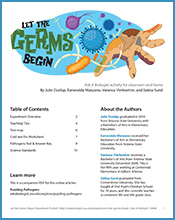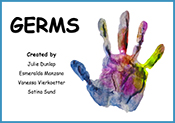Teaching Kids About Germs
This activity introduces students to pathogens or “germs” and how they are transmitted.
Teaching Tips
This is a multi-day activity that integrates Common Core Reading Standards with NextGen Science Standards.
Objectives
Students will be able to identify how pathogens are transmitted and brainstorm ways to keep their classroom healthy.
Day 1
 Guide students through the Puzzling Pathogens story and the Cold and Flu Worksheets (provided in the experiment packet).
Guide students through the Puzzling Pathogens story and the Cold and Flu Worksheets (provided in the experiment packet).
Students should discuss their first inquiry question, “What are some signs you are sick?” and they should compare the cold and the flu.
Day 2
Start off with these activities:
- Direct transmission: Remember which cup held the clear indicator (phenolphthalein). Students record with whom they share water. Reveal who started with the infection so the class can trace the spread. When they’ve finished, add red indicator to each cup. The fluid will change color for those who have been “infected”.
- Indirect transmission: Before class or during lunch, spread “germ juice” on a surface (e.g., door handle). After completing one or both of the other activities, use a black light in the dark on students’ hands, seeing who and what objects have been affected. Make sure students wash their hands before they go to lunch or go home.
- Airborne transmission: Ask a student to fake sneeze with the spray bottle from the middle of the room and see who feels the water. Using a meter stick, have students measure the distance the “germs” spread. This can lead to testing of how covering mouths when sneezing affects the spread of germs.
Review and clarify concepts using the Traveling Germs Slideshow (PDF | PPT).
Day 3
Students will create a Tree Map (worksheet included) based on the main Germs Slideshow (PDF | PPT).
A Tree Map is used to classify objects. Have students label the four columns: (1) bacteria, (2) viruses, (3) fungi, (4) protozoa. Before going over the PowerPoint, write down questions you’d like the students to answer in their tree maps. You can choose your own questions based on information you will add to the presentation, or use the following set questions: “What is it?,” “What illnesses might it cause?,” and “What is its environment?”
Day 4
Start with the inquiry question “What are some ways we could prevent spreading bacteria and viruses?” Have student groups come up with skits that demonstrate ways they can answer this question.
Finally, have your students take the pathogens test.
Tips for Classroom Implementation
Time Required
- Day 1: 30 minutes
- Day 2: 90 minutes
-
Day 3: 30 minutes
- Day 4: 45 minutes
You Will Need
- water
- cups (1 per student)
- meter stick or tape measure
- spray bottle
- GermJuice (or equivalent)
- phenolphthalein indicator
- black light
- Germs Experiment Packet (PDF)
- Cold and Flu worksheets (included in packet) for each student
- Pathogens test (included in packet) for each student
- Tree Map worksheet (included in packet) for each student
- Traveling Germs Slideshow (PDF | PPT)
- Germs Slideshow (PDF | PPT)
Classroom Set-up
Day 1: Each student receives a copy of the Cold and Flu worksheets included in the experiment packet.
Day 2: You will need the Traveling Germs Slideshow (PDF | PPT) as well as: water, cups, clear indicator in one cup, red indicator, germ juice (GermJuice’s Jr. Hand Washing Kit is suggested), black light, spray bottle.
Day 3: Germs Slideshow (PDF | PPT), tree map print outs.
Day 4: Space for students to work on their skits, pathogens test.
Tips
Discussion is essential throughout these lessons. Make sure you allow enough time for students to discuss and process the presented information. Use the two inquiry questions to guide discussion and learning.
Extensions
Ask students how they could help prevent the spread of disease in other classrooms.
Prompt students to do research and find specific examples of each type of transmission (which infections spread better by which route?).
Standards
Arizona Science Standards
Strand 1: Inquiry Process (Grades 3-4)
Concept 1: Observations, Questions, and Hypotheses
Observe, ask questions, and make predictions.
- PO 1. Formulate relevant questions about the properties of objects, organisms, and events of the environment using observations and prior knowledge.
- PO 2. Predict the results of an investigation based on observed patterns, not random guessing.
Concept 2: Scientific Testing (Investigating and Modeling)
Design and conduct controlled investigations.
- PO 1. Demonstrate safe behavior and appropriate procedures (e.g., use and care of technology, materials, organisms) in all science inquiry.
- PO 2. Participate in guided investigations in life, physical, and Earth and space sciences.
- PO 3. Conduct simple investigations in life, physical, and Earth and space sciences.
- PO 4. Measure using appropriate tools (e.g., ruler, scale, balance) and units of measure (i.e., metric, U.S. customary).
- PO 5. Record data in an organized and appropriate format (e.g., t-chart, table, list, written log).
Concept 3: Analysis and Conclusions
Analyze and interpret data to explain correlations and results; formulate new questions.
- PO 2. Construct reasonable interpretations of the collected data based on formulated questions.
- PO 3. Evaluate the reasonableness of the outcome of an investigation.
Strand 4: Life Science (Grade 3)
Concept 3: Populations of Organisms in an Ecosystem
Understand the processes acting on the Earth and their interaction with the Earth systems.
- PO 2. Examine an ecosystem to identify microscopic and macroscopic organisms.
- PO 5. Describe how environmental factors in the ecosystem may affect a member organism's ability to grow, reproduce, and thrive.
Common Core Standards
- RI.5.2: Determine two or more main ideas of a text and explain how they are supported by key details; summarize the text.
- RI.5.9: Integrate information from several texts on the same topic in order to write or speak about the subject knowledgeably.
- RI.6.8: Integrate information presented in different media or formats as well as in words to develop a coherent understanding of a topic or issue.
Next Generation Science Standards
- MS-LS1-1: Conduct an investigation to provide evidence that living things are made of cells; either one cell or many different numbers and types of cells.
- MS-LS1-2: Develop and use a model to describe the function of a cell as a whole and ways parts of cells contribute to the function.
Read more about: Let the Germs Begin
Bibliographic details:
- Article: Germ Activity: For Teachers
- Author(s): Dr. Biology
- Publisher: Arizona State University School of Life Sciences Ask A Biologist
- Site name: ASU - Ask A Biologist
- Date published:
- Date accessed:
- Link: https://askabiologist.asu.edu/let-germs-begin/teachers
APA Style
Dr. Biology. (). Germ Activity: For Teachers. ASU - Ask A Biologist. Retrieved from https://askabiologist.asu.edu/let-germs-begin/teachers
Chicago Manual of Style
Dr. Biology. "Germ Activity: For Teachers". ASU - Ask A Biologist. . https://askabiologist.asu.edu/let-germs-begin/teachers
Dr. Biology. "Germ Activity: For Teachers". ASU - Ask A Biologist. . ASU - Ask A Biologist, Web. https://askabiologist.asu.edu/let-germs-begin/teachers
MLA 2017 Style

This activity has a companion article. Learn more about germs in Puzzling Pathogens.
Teaching tools:
Experiment Packet (PDF)
Germs Slideshow
(PDF | PPT)
Traveling Germs Slideshow
(PDF | PPT)
Be Part of
Ask A Biologist
By volunteering, or simply sending us feedback on the site. Scientists, teachers, writers, illustrators, and translators are all important to the program. If you are interested in helping with the website we have a Volunteers page to get the process started.




